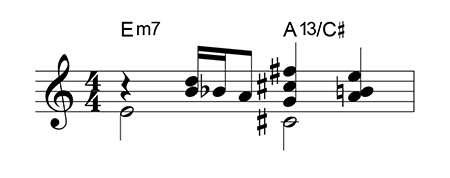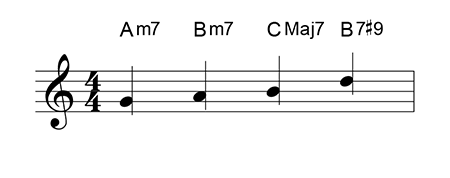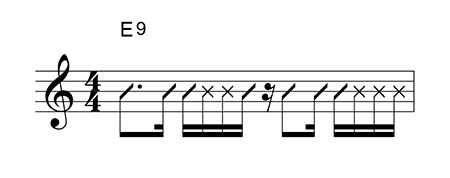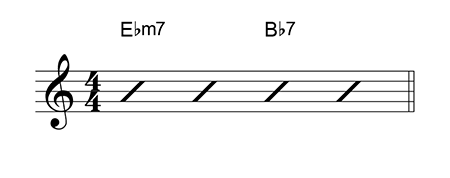 Music notation plays a huge role in both sides of my double life. By day, I work at MakeMusic, where my primary tasks involve transferring published sheet music into SmartMusic. On nights and weekends I play guitar in a variety band. Unlike the published music I encounter by day, charts for this band are often hastily made, with little regard for the finer points of copy work. The results can sometimes look like the excerpt above, which is clearly not optimal for sight reading (or anything else).
Music notation plays a huge role in both sides of my double life. By day, I work at MakeMusic, where my primary tasks involve transferring published sheet music into SmartMusic. On nights and weekends I play guitar in a variety band. Unlike the published music I encounter by day, charts for this band are often hastily made, with little regard for the finer points of copy work. The results can sometimes look like the excerpt above, which is clearly not optimal for sight reading (or anything else).
After reading many bad charts, I’ve begun to recognize some of the most common pitfalls people encounter when writing pop music for performance. Today, we’ll examine some of these bad habits and share quick ways to correct them in your work.
Beaming, Rests and the Invisible Barline
Beaming and rest choices are often ignored by the lazy copyist, but a little extra effort here will lead to better performances.
The meter of a measure must always inform the notation. Every time signature implies a grouping of beats, which determine beaming and rest choices. Take the following excerpt as an example. Which is clearer?

Most working musicians could play the first example correctly after some practice time, but ideally we’d like these charts to be sight read, as is typical on the gig. By contrast, the second example clearly defines the halfway point in the measure, which is a great aid to readers. This is a concept known as the “Invisible Barline,” and is vital to writing in an even meter.
Additionally, notice how the beaming has been changed to outline each beat in the measure. This practice makes it easier to subdivide rhythms while reading the piece. Proper beaming technique is especially important in complex meters:

The engraver’s rests must also support the performer by outlining the meter. I find each of the following measures to be very difficult to read:  Here is the same example with appropriate rests and beaming:
Here is the same example with appropriate rests and beaming: 
Note that each syncopation is split into multiple rests. Again, this helps the performer subdivide rhythms easier. When mixed rests are needed, always choose rests which outline the beat appropriately.
Writing Chords
Another challenge for many writers is using chord notation. While this is a large topic that I’ve covered before, here are some basic guidelines to remember when building parts for the rhythm section.
First and foremost, develop a system that works for your performers. If your musicians prefer to see a ø7 chord suffix instead of min7 b5, then you need to swallow your pride and write the chord they want – even if you believe it’s “wrong.” Never sacrifice a good performance in the name of being “right.”
Just make sure to stay consistent – don’t write “C-7” in one measure, “Cm7” in the next and “Cmin7” later.
Comping Notation
Suffixes aren’t the only important part of writing chords; you must also pay attention to notation in the staff. While the lazy copyist may not see the value in writing notation during a comping part, the performers often need it badly, and each member of the rhythm section expects different conventions.
When in doubt, keep the notation simple. Here are some of my rules of thumb for writing rhythm section parts.
1. If you know exactly what notes you want them to play: write the notes in the staff. (This should be rare.)

2. If you only have a few specific notes: write the rhythms in the staff and only the specific notes you want. (This is common for guitar players, who often remember voicings based on the top note of the chord.)

3. If you don’t care what voicing they use but you have a specific rhythm: write rhythmic slash notation. (Common in a score with ‘hits’ that the band plays together.)

4. If you want them to improvise a comping part: Use slash notation. (This is the most common and easiest way to notate chords, but your performer may not know exactly what to play.)
 Being a guitarist, I wrote all of these examples for a guitar part. However, the same rules apply to other instruments. Typically, the bass part is written with a sample bassline and chord symbols – that way, the bass player has an idea of what groove to play, but they can freely ad lib fills when appropriate.
Being a guitarist, I wrote all of these examples for a guitar part. However, the same rules apply to other instruments. Typically, the bass part is written with a sample bassline and chord symbols – that way, the bass player has an idea of what groove to play, but they can freely ad lib fills when appropriate.
 In part two of this post, we’ll step back a bit and turn our attention to how your refined notation appears on the page, discussing phrasing and layout.
In part two of this post, we’ll step back a bit and turn our attention to how your refined notation appears on the page, discussing phrasing and layout.
 Peter Flom is the production manager in the repertoire development department at MakeMusic. A graduate of the Berklee College of Music, Peter has previously worked at KMA Studios in New York City, and in MakeMusic’s Customer Success department. He now spends most of his days developing new content for Finale and SmartMusic, and has worked with many publishers along the way.
Peter Flom is the production manager in the repertoire development department at MakeMusic. A graduate of the Berklee College of Music, Peter has previously worked at KMA Studios in New York City, and in MakeMusic’s Customer Success department. He now spends most of his days developing new content for Finale and SmartMusic, and has worked with many publishers along the way.
He also is a freelance arranger and engraver, and plays a mean guitar when no one’s watching.